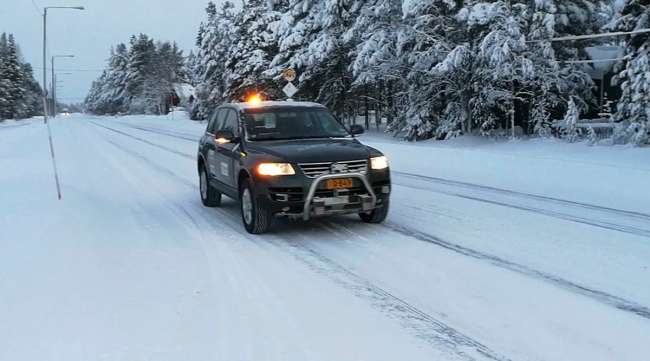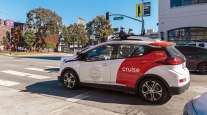If You Hate Driving in the Snow, a Robot Can Now Do It For You

Self-driving cars may be the future, but relinquishing control of the wheel certainly takes some getting used to. It’s one thing to go (slowly) with the flow on well-marked city streets, for which many self-driving cars were initially developed and tested, but what happens when you throw icy winter road conditions into the mix?
The minds at VTT Technical Research Centre of Finland seek collectively to reassure us with Martti, which they claim is the first fully autonomous car to handle a snow-covered public road safely, without spinning out on a patch of black ice and death spiraling over a cliff. (OK, no autonomous vehicle ever has death spiraled, to our knowledge, but such are our fears.) According to a press release, Martti, a retrofitted Volkswagen Touareg, hit 25 miles per hour on snowy roads without lane markings in Finland’s famously frigid Lapland region and likely could go faster without issue.
RELATED: Minnesota DOT tests driverless shuttle bus
RELATED: Self-driving vehicle proving ground opens near Detroit
Most other self-driving cars rely on Lidar—that’s Light Detection & Ranging, which uses light from a pulsed laser to measure distances between objects—but it doesn’t work well in whiteout conditions. Martti is different, uniquely outfitted to function properly even “when turbulent snow degrades 3D-sensor performance,” said project manager Matti Kutila in an email to Bloomberg News. “The trick is to adapt filters,” he continued; “filter” is another way of saying “algorithm.” Martti relies on radar, three forward-facing lasers, and a mix of cameras, antennas, and sensors, plus a rear-mounted Lidar for good measure.
Kutila told Bloomberg he doesn’t anticipate that Martti will hit the streets for real any time soon—current street maps aren’t accurate enough to ensure a completely seamless ride. But he anticipates that the company will sell the underlying software that processes Martti’s sensor data and gives it driving commands, technology that could one day power buses and cars conveying skiers up and down a mountain, much as how cruise companies are developing driverless vans to ferry passengers around ports.
“This is exactly the point,” said Kutila. ”Cars and vehicles can use this technology to do something which brings skiers from hotel to the slope.”
VTT isn’t the only autonomous car outfit to test in the snow, but since Martii is specifically designed for the purpose, it has a head start; real-world tests began early this past autumn. By comparison, Russian software giant Yandex’s model has hit only private roads, and Google’s Waymo saw snow for the first time just last month.
There’s still a lot more tinkering to do, says VTT. It plans to increase the resolution of Martti’s radar system, rejigger the wavelengths of its optical components, and strengthen the software that monitors its sensors. By mid-January, it’ll be able to communicate with digital transport infrastructure—that’s traffic and weather-related information already provided by governments and institutions—and by next spring, it’ll be tested in forest environments.
It’s unclear at this point what all this means for consumers. By Kutila’s own admission, Martti doesn’t offer the smoothest ride in the world. “It’s a prototype and not as comfortable as driving manually,” he said. “However, when the car starts doing decisions himself, it feels a bit like a human—and you even start talking to the car, ‘What are you doing?’” (A familiar question to anybody who is a parent or has ever driven in inclement weather with one.)
Kutila believes it’ll still be years until consumer-facing driverless cars are on the road. We’ll see automated functions in vehicles—think valet parking—before that happens. College and professional campuses might also adapt their shuttles to support automated driving; Kutila predicts “they will be fully automated by 2020.”
As for a complete overhaul of everyday transportation?
“Changing all traffic to automated mode takes lot of time, and we are talking about a transition period of 20 to 30 years,” he said.




